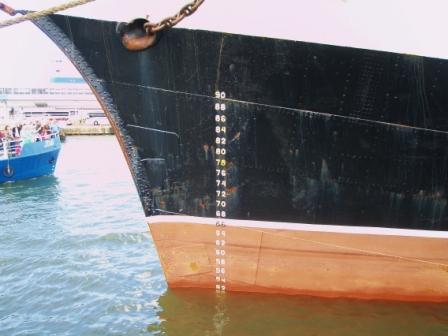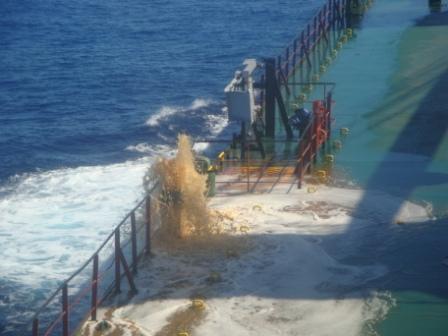Every time on the ship when you go for a loading or discharging of cargo, you take drafts every day morning and evening. There will be a question that comes to your mind why do we take a draft? when the first time I joined the ship as Cadet then I did not even know about the ship and I also had this question in my mind, in this article I will tell you that Why do we take drafts and how to take a ship’s draft. we take a draft of the ship:
- To find the displacement of the ship at any time.To calculate the cargo loaded or discharged.
- To adjust the loading and other consumables on board in such a fashion as to arrive at a particular draft in a depth-restricted port.
Before we get further on and start reading the ship’s draft let us see learn about load line marks and how they came into being.
- A ship is a floating object and for it to float it needs a certain amount of buoyancy.
- (We hope you all remember the Archimedes Principle)
- Any ship, when loaded beyond its limit, will reduce the buoyancy of the ship thereby rendering it unsafe.
- An overloaded ship is an unsafe ship as it does not then have sufficient reserve buoyancy.
- Hence to ensure that the ship is safe at all times a British Member of Parliament by the name of Samuel Plimsol introduced a regulation in the Merchant Shipping Act of 1876. This law requires all ships to have load line marks on each side of the ship.
- Thus the load line mark became known as the Plimsol Mark. This was to bring about shipboard safety for seamen against overloading for commercial gain by unscrupulous ship owners…
Loadline marks are normally marked amidships on the shipside on both port and starboard sides. Depending on the climatic condition and weather encountered, the oceans of the world are divided into 3 zones.
Summer (S)
Winter (W)
and tropical (T)
The present regulation dealing with load-lines is the LOADLINE REGULATION of 1966. All details of the load line marks and how they are assigned are given in these rules. A shipowner can be fined heavily and sometimes the ship is detained by shore authorities for non-compliance with these rules.
Some areas of the oceans also fall into the category of seasonal zones. This is a particular zone that is treated as a summer zone during certain months and tropical or winter zones during the other months of the year.
(See the zone chart on your ship. This chart will also be displayed on the bridge and in the cargo office.)
Some examples of use for these load line marks
When a ship is trading exclusively in a particular zone, for example, the summer zone. The midship draft of the ship must never exceed the summer load line during any stage of the voyage.
- If the ship on a particular voyage has to cross various zones during the voyage then the Midships draft should never exceed the load-line mark for the current.
So if a ship enters a winter zone from a summer zone area the draft when entering the winter zone and throughout the time the ship is in the winter zone must not exceed the winter load line.
Look at the load line marks shown in this figure.
Loadline marks:
- Deckline: This line is marked amidship in lime with the uppermost continuous plating (weather deck) where it meets the sheer strake (the uppermost strake of the ship’s side plate)
The deckline is 300 mm long and its upper edge is in line with the uppermost continuous watertight deck.
- Vertically below the deck line is a round circle whose outside diameter is 300 mm. This is called the load line disc.
- The Plimsoll line is the horizontal line that cuts through the load line disc. On this line the initials of the assigning authority are marked, in this case, the letters BV represent the Classification Society called Bureau Veritas.
- The Loadline markings are marked on the right side of the Plimsol marks when viewing the shipside on the starboard side and left the side of the Plimsol mark when viewing the shipside on the port side.
- When the vessel is in a tropical zone and in freshwater of density 1,000 the ship may load up to the upper edge of mark ‘TF’ (Tropical Fresh)
- When in the freshwater of density 1,000 and in the tropical summer zone a ship may load up to the upper edge of the line marked “F” (Fresh)
- When in salt water of density 1025 and in the tropical zone the maximum the vessel can load is to the upper edge of the line marked “T” (Tropical)
- When the ship is in the summer zone and in the seawater of density 1025 she must not load more than the upper edge of the line marked ‘S’. This is the SUMMER LOAD LINE of the vessel and it passes through the center of the load line Disc. The displacement when the ship is loaded to the line is known as the “SUMMER DISPLACEMENT”
- The ship can only load up to the upper edge of mark “W” when loading in the winter zone in a seawater density of 1025.
- The mark “WNA” is assigned to small ships less than 100 meters in length in the North Atlantic where the sea is so rough in winter. WNA stands for winter North Atlantic. Here smaller ships need more freeboard so they are not even allowed to load up to the ‘W’ mark. They can only load up to the upper edge of the ‘WNA’ mark which is 50 mm lower than the ‘W’ mark.
Reading Draft Marks
when the markings are in meters, the main meter marks are marked as Arabic manuals followed by the letter M such as 8M, 9M, and 10M, or in letters such as VIII, IX, X. In between the metric marks are Arabic numeral markings such as 2, 4, 6, and 8 to indicate 20 cm, 40cm, 60 cm, and 80 cm. The height of each mark is 10 cm and the distance between the mark is 10 cm.
If the water is just in line with the mark 10M or X the draft is 10.0 meters. If the water is in line with the top edge of 10 M, then the draft is 10.10 meters, and so on. The diagram clearly explains the reading.
When the draft markings are in feet, for each mark (whether Arabic numerals or Roman letters) the height of the mark is 6″ and the distance between them is also 6″.
Measuring the draft in a swell
In heavy sea conditions, there may be waves, swell, pitching, and rolling to take into account.
There are two methods of taking a draft reading in such a condition.
1st Method:
- Obtain a total of 12 mean readings.
- The highest and lowest means should be rejected.
- Average the remaining ten and this will give the most accurate reading possible.
2nd Method:
- Reading is done using the wave cycle.
- Normally one wave out of every five waves will be absolutely calm.
- Read the draft at that particular wave a few times and average the same.
- This reading will give an accurate reading.
Some hints for draft reading
- The principle of draft surveys:
weight of a loaded ship – the weight of an empty ship = the weight of the cargo.
Apart from cargo, there are other consumables on board the ship like fresh water, fuel, stores, and maybe un-pumpable ballast which need to be accounted for when calculating cargo by means of a draft survey.
- When taking the initial and final drafts in a load or discharge port
Ensure that nothing should be moving when reading the drafts – no cargo transfers, ballast, stores, fuel transfers, or hatch covers. The accuracy of reading may be affected if any of these operations is in progress when taking the draft. This may not be practical when taking regular AM and PM drafts as it may not be possible to stop cargo work every time you want to take a draft.
- Draft marks should be read from as close to the waterline as possible, in order to avoid errors due to parallax. Those read from a boat at rest with no wash are likely to be the most accurate.
- It is possible that at times the midship mark may not be clearly visible on the side the ship is alongside. Then the distance from the waterline to the deck is measured and this is deducted from the deck height which can be obtained from the ship’s plan.
- Take draft readings preferably at slack water as the ship may squat due to strong tide or current in shallow water and so the draft read during these times may not reflect the true, free-floating draft.
- When taking a draft without a draft measuring instrument in a swell it is best to take the highest and lowest readings of a series of swells and then calculate the average, as described above.
- Some useful equipment to be kept handy when reading a draft is a hand lamp or touch with a powerful beam and a pair of Binoculars.
- Draft gauges if fitted on board should not be entirely relied upon. Visual draft readings should be used to calibrate draft gauge readings on a regular basis.





I want to know how to confirm ship’s fwd and
aft draft, by taking only ship’s midship draft
How to determine seaside fwd and aft draft, after knowing the midship draft on both side.